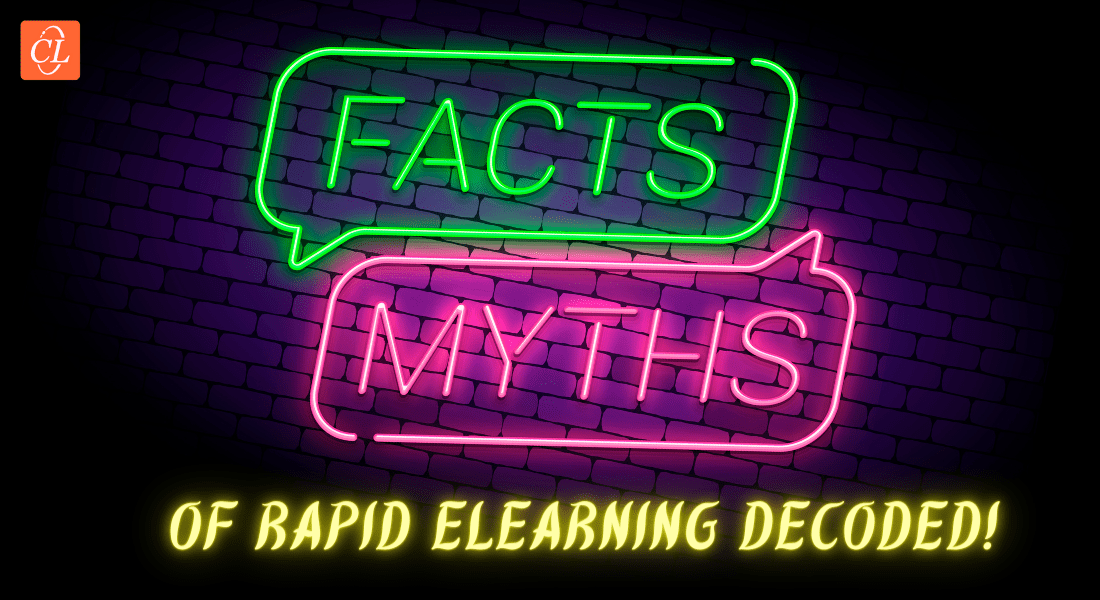How to Develop Rapid eLearning Courses from Approved Storyboards: Guide

The eLearning landscape is evolving rapidly. Gone are the days of lengthy development cycles for eLearning courses. Today, Instructional Designers (IDs) can leverage the power of rapid eLearning development to create engaging and effective learning experiences in a fraction of the time. This approach streamlines the process, reduces costs, and allows you to meet tight deadlines without compromising quality.
But how do you translate an approved storyboard into a compelling eLearning course using rapid development techniques? This guide walks you through every step of the process, equipping you with the knowledge and best practices to bring your learning vision to life quickly and efficiently.
How Authoring Tools Accelerate Rapid eLearning Development?
Rapid eLearning development hinges on efficient course creation. Authoring tools empower IDs with features that streamline this process:
- Pre-designed templates: Save time by leveraging pre-built templates for common course elements like knowledge checks and interactive modules.
- Drag-and-drop functionality: Intuitively build your course by dragging and dropping text, images, and multimedia elements onto the editing canvas.
- Content libraries: Access pre-built assets like icons, images, and video clips to enrich your course content without external sourcing.
- Reusable elements: Create and store reusable learning objects (e.g., interactive exercises) for faster course assembly and consistency across modules.
These features within authoring tools significantly reduce development time, allowing IDs to focus on crafting engaging learning experiences within the rapid eLearning framework.
How to Develop Rapid eLearning Courses from Approved Storyboards?
1. Developing a Prototype: Refining the Storyboard for eLearning
The first step in rapid eLearning development is to refine your approved storyboard for the eLearning environment. While the core structure remains the same, consider the functionalities and limitations of your chosen authoring tool.
- Storyboard Review: Collaborate with SMEs (Subject Matter Experts) to ensure the storyboard accurately reflects the learning objectives and content accuracy.
- Chunking Content: Break down complex topics into smaller, manageable modules that align with microlearning principles.
- Interactive Integration: Identify opportunities to incorporate engaging interactivities, such as drag-and-drop exercises, branching scenarios, or knowledge checks.
- Storytelling Elements: Emphasize storytelling techniques within the storyboard, using narrative elements to captivate learners and enhance knowledge retention.

Best Practice: Involve the eLearning developer during the storyboard review process. Their expertise can help ensure the storyboard translates smoothly into the chosen authoring tool while maximizing its potential for interactive elements.
2. Authoring Tool Selection and Course Development
With a refined storyboard in hand, it's time to choose an authoring tool. Rapid eLearning authoring tools provide user-friendly interfaces and pre-built templates to expedite course development. Consider factors like:
- Features: Does the tool support the interactivities and multimedia elements envisioned in the storyboard (e.g., audio, video, branching scenarios)?
- Ease of Use: Is the interface intuitive and user-friendly for IDs with varying levels of technical expertise?
- Mobile Compatibility: Does the tool create responsive eLearning designs that adapt seamlessly to desktops, tablets, and smartphones – crucial for mobile learning?
Emerging Technology: Explore authoring tools incorporating generative AI (Artificial Intelligence). These tools can automate tasks like content creation, personalize learning experiences, and offer accessibility features.
Best Practice: Look for authoring tools that offer free trials or demos. This allows you to test drive functionalities and ensure it aligns with your project needs before committing.
3. Interactive Development: Bringing the Storyboard to Life
Now comes the exciting part – breathing life into your storyboard! Leverage the power of interactive elements to create engaging learning experiences. This is where your creativity and understanding of adult learning principles take center stage.
Interactivity Types:
- Scenario-based learning: Present learners with realistic situations to apply their knowledge and make critical decisions.
- Gamification: Incorporate game mechanics like points, badges, and leaderboards to boost motivation and engagement.
- Quizzes and Assessments: Use interactive assessments to gauge learner comprehension and personalize learning paths based on their performance.
- Simulations: Create realistic simulations that allow learners to practice skills in a safe environment

Best Practice: Strike a balance! Don't overload the course with too many interactivities. Use them strategically to reinforce key learning points and keep learners engaged.
→ Download Now: The 4 Rs of Rapid eLearning [FREE eBook]
4. Multimedia Integration: Adding Sensory Appeal
Multimedia elements can significantly enhance the learning experience. However, proper selection and integration are crucial to avoid information overload.
- Audio Narration: Professional narration adds clarity and personality to the course.
- Images and Videos: Use high-quality visuals that complement the content and reinforce learning objectives.
- Microlearning Videos: Consider incorporating bite-sized video lessons for efficient knowledge transfer.
How to Create Engaging Microlearning Videos? [Video]
Best Practice: Prioritize accessibility. Ensure all multimedia elements include captions and transcripts for learners with disabilities.
5. Quality Assurance and Test Run: The Final Polish
Before deployment, a thorough quality assurance (QA) process is essential.
- Technical Review: Test the course functionality across different devices and browsers to ensure smooth operation.
- Content Accuracy: Double-check the content for accuracy, grammar, and consistency with the storyboard and learning objectives.
- Accessibility Testing: Verify that the course is accessible for learners with disabilities by using automated testing tools and conducting user testing with accessibility specialists.
- Pilot Test Feedback: Gather feedback from pilot test participants on the course clarity, engagement level, and overall learning experience. Use this feedback to refine the course before full deployment.
Best Practice: Utilize rapid eLearning development's iterative nature. Feedback from the QA process and pilot test can be quickly incorporated into the course, allowing for swift revisions and improvements.
6. Deployment and Beyond: Continuous Improvement
With the final polish applied, it's time to launch your eLearning course!
- Learning Management System (LMS) Integration: Publish the course to your chosen Learning Management System (LMS) for easy access and management for learners.
- Learner Tracking and Analytics: Leverage the LMS capabilities to track learner progress and analyze key metrics such as completion rates, assessment scores, and learner engagement.
Best Practice: Don't let the launch mark the end of the process. Use the learner analytics data to identify areas for improvement and iterate on the course content based on learner needs. This continuous improvement cycle ensures your eLearning offering remains relevant and effective.
Conclusion: Rapid eLearning Development – A Powerful Tool for Modern Learning
Rapid eLearning development empowers IDs to create high-quality, engaging learning experiences in a shorter timeframe and with reduced costs. By following the steps outlined above and embracing best practices, you can leverage this powerful approach to meet the ever-evolving needs of modern learners.
Download our FREE eBook: The 4 Rs of Rapid eLearning and discover a comprehensive framework to streamline your development process, boost learner engagement, and deliver exceptional results – all within a tight timeframe.





